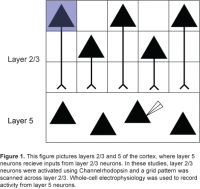The ability to change the strength of connections between neurons, known as synaptic plasticity, has been shown to be extremely important for learning and memory within the brain. One proposed mechanism for how this ability manifests is known as hetereosynaptic plasticity, whereby changes in synaptic strength occurs at a synapse not active during training or induction. However, one of the challenges of studying hetereosynaptic plasticity is that a large number of synapses are required to study the mechanism and it is extremely difficult to study multiple synaptic inputs to a single neuron within one experiment. Here, Simonova et al., developed a protocol to help overcome this by studying the plasticity of synapses between cortical neurons using optogenetics and patterned illumination.

To carry out their protocol, Simonova et al. virally expressed channelrhodopsin-2 in pyramidal neurons of cortical layers 2/3, and conducted whole cell patch clamp recordings of layer 5 pyramidal neurons to record their responses to said presynaptic L2/3 inputs. Traditionally, methods of studying hetereosynaptic plasticity only allow for the study of 1-2 synaptic pairs due to experimental limitations on how many different synapses can be stimulated. To overcome this, the authors utilized Mightex’s DMD-based Polygon400 pattern illuminator with its built in grid scan function to optogenetically stimulate different synapses. By utilizing the grid scanning feature of the Polygon400, the authors were able to stimulate different synapses as shown through the differences in cellular response after stimulating in different grids (Figure 1). Simonova et al. also conducted important controls to test what the most optimal matrix size would be for their experiments. Interestingly they settled on grids roughly 38 x 38 μm in size as they noted that higher resolutions and longer durations would be too slow for their experiments. Furthermore, they settled on a stimulation duration of 1 millisecond since this length of time showed reliable and reproducible activation of neurons.
By implementing this novel use of grid-scanning, Simonova et al., were able to find similar results to previous work showing that there was a strong positive correlation between paired pulse ratios of synapses and said synapse’s changes in postsynaptic potential after intracellular tetanization (a protocol used to test hetereosynaptic plasticity).
To learn more about the Polygon400, click here. Or, read our white paper comparing tools for neuroscience optogenetics.
To read the full paper, click here.
Simonova, N.A., Bal, N.V., Balaban, P.M., Volgushev, M.A., & Malyshev, A.Y. (2019). An Optogenetic Approach to Studies of Heterosynaptic Plasticity in Neocortical Neurons. Neuroscience and Behavioral Physiology.



